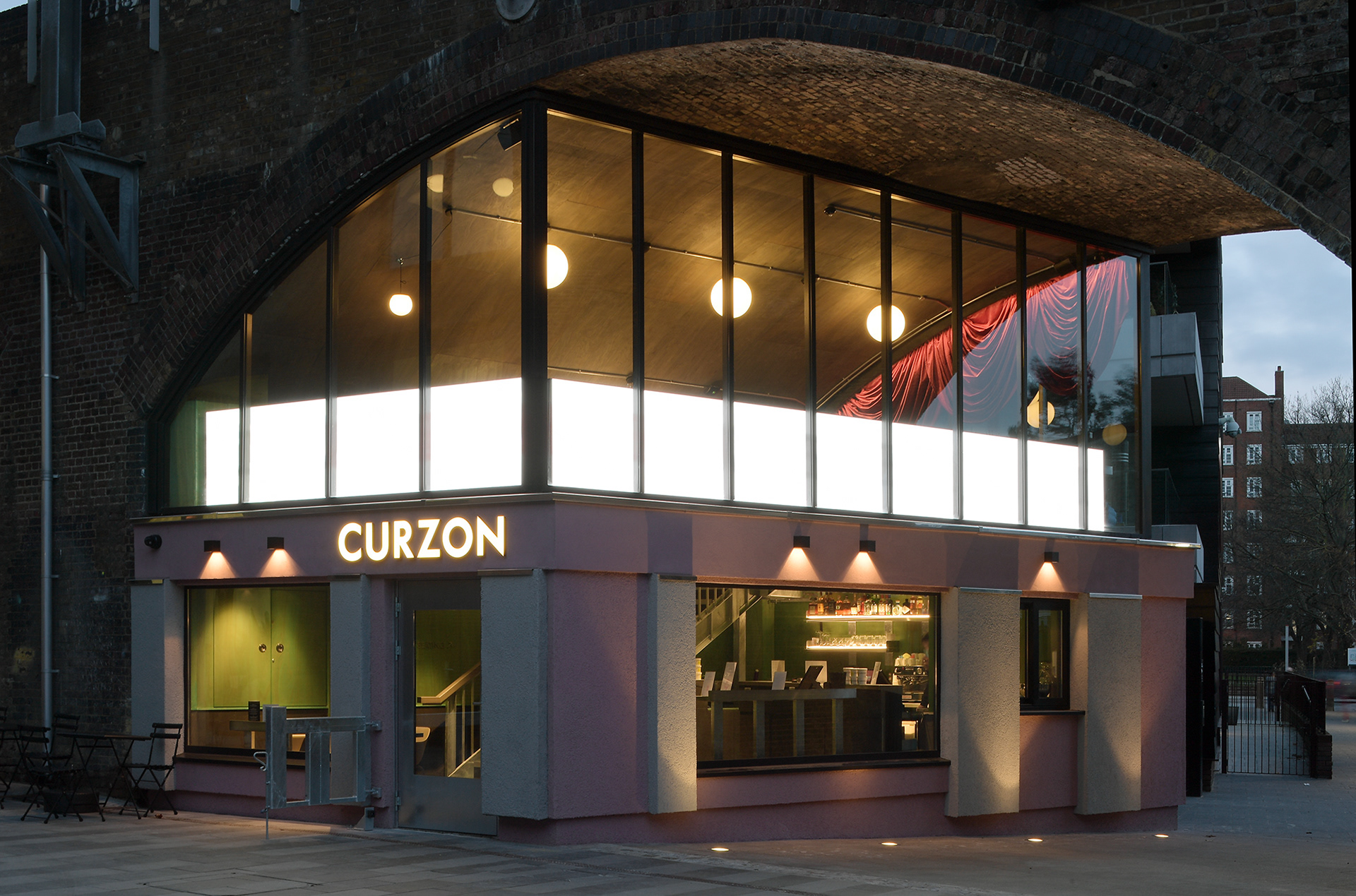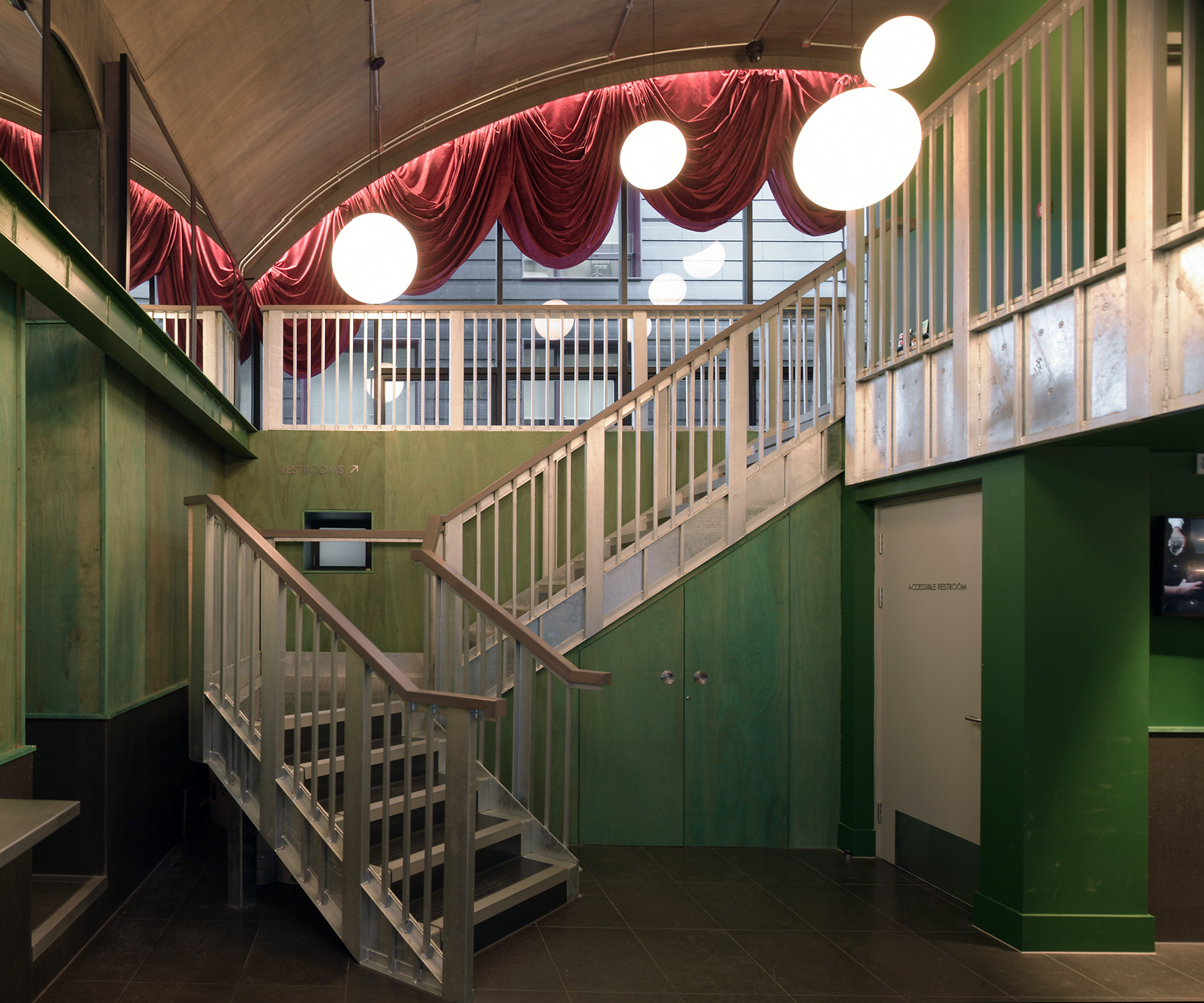









Curzon Camden Cinema
TAKERO SHIMAZAKI ARCHITECTS
Camden’s new cinema represents the adaptation and renewal of the once industrial infill lining its viaducts. The ambition for our second Curzon location sought to retain as much of the landlords pre-existing shell as possible, re-purposing the building fabric installed as part of the larger Hawley Wharf regeneration. Working with the inherited materials, we inserted new architectural elements with their own language which now define the public spaces of the cinema.
Although working with plywood, galvanised metal and structural steel, we set out to elevate otherwise modest building materials with the addition of stone and render. Our intention was a sense of ‘otherness’, something different to what was there before. It was important to us and Curzon not to conform to the often appropriated industrial warehouse typology. Instead, the interventions are individual arched spaces with expressed facades, colours, material textures, tactility, fabric, light and shadow.
We explored the notion of lightness and weight occurring simultaneously. The existing arches have a sense of material, structural and historical weight. We inserted new elements of lightness - using as little new material and resource as possible. We simultaneously composed a palette of materials from the existing and created architectural gestures of weight through the expression of beams and vertical rhythm.
The relationship of internal and external spaces borne out of the nature of these arches and the separateness of each public space makes for a blurred architectural connection to the urban context. The cinema’s visitors pass inside and out between the fantasy of film, Camden’s urban alleyways and the more open public bar spaces within a single journey.
The auditoriums, café and bars are connected, yet separate. They are individual spaces, each with their own door to the street. The project proposes an architectural scenario of urban niche-like parasitic interventions, fitting into the existing industrial infrastructure - adapting into a re-use architecture of lightness and weight.
Located directly adjacent to the Regents Canal and forming part of the Hawley Wharf Camden Lock Village Development, Curzon Camden cinema occupies Arches N7 to N14 of Railway Viaduct 4. Of the 8 arches, 7 are fully inhabited while the new Café occupying the eastern most N7 shares its volume with a pedestrian route between the Regents Canal Towpath and Hawley Road. Prior to the Camden Lock Village development, the railway arches in the area provided workshops and storage to many small industries and remain intrinsically linked to the history of the Camden area. Works completed as part of the wider development masterplan had prepared the arches for speculative retail inhabitation through steel deck mezzanines, internal plywood linings and steel framed powder-coated curtain walling. Inheriting this as found condition, t-sa worked with Curzon and the design team to transform the arches for cinema use, retaining, modifying and refinishing the existing building fabric wherever possible.
Access to the site from the south passes beneath an adjacent viaduct, framing oblique views of arch N7, animated by its continuous digital readograph. Internally, N7 serves as a café space with ground floor barista and mezzanine level seating. The adjacent arches N8 and N9 are linked internally via the existing jack arch and serve as the main front of house accommodation. The existing mezzanine structure was retained in N8 but modified to allow a generous double height space upon entering with a bar adjacent and WC’s above. Mezzanine access is via a bespoke galvanised steel stair which together with external door guarding, balustrades and lean bars forms a family of galvanised metalwork. For N9, the mezzanine was removed to reveal the height and geometry of the enclosing arch in its entirety.
Arches N10 to N14 each hold a 30-seat auditorium, accessed directly from the street through an acoustic lobby. Independent steel frame structures were inserted to separate the interior fabric from the enclosing brick viaduct, acoustically isolating each auditorium. Integration of services was carefully considered to ensure the geometry of each arch was retained either side of a central service route, revealing itself externally through recessed ventilation ducts. The character of each auditorium is defined by colour, where a strong contrast exists between each arch and tonal variation can be perceived between the fabric linings of walls and seats.
Externally, the existing curtain walling was retained where possible and the plywood hoarding at ground level replaced with a new elemental language of projecting columns and beams. Where programmatic and acoustic considerations dictated opacity for each auditorium, large windows were incorporated throughout the front of house. Consideration was given to balance views and external presence with the desire for an intimate atmosphere within. The facades are further animated by the thoughtful composition of surface fittings including awnings, lights and signage. Reference to the industrial heritage of the site exists through re-use of the arches urban numbering but otherwise the façade seeks to instil a civic architecture. External render was used to achieve the suggestion of a monolithic construction, contrasting significantly with the industrial heritage of the existing brick and achieving a seamless finish against the awkward geometry of the surrounding arch. Extensive consultation was undertaken with Camden Council to agree a mix of textures and colours using multiple aggregates and pigments, complimenting the tonal variations in the existing brick.
Internally, the approach of re-use is continued throughout the front of house with existing plywood linings to walls and soffits stained in-situ. Where necessary, new plywood was used for internal joinery elements and lightweight studwork partitions were decorated in a contrasting darker tone. Artefacts of the landlord’s speculative fitout can be perceived throughout with seemingly redundant beams overhead providing lateral restraint to the façade construction. Large format stone tiles line the floor and walls at low level, elevating the otherwise modest material palette and a sense of theatricality is embraced as mid-level mirrors blur the spatial boundaries.
Photographs © David Grandorge
